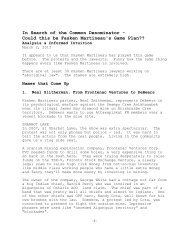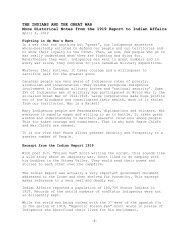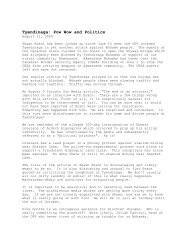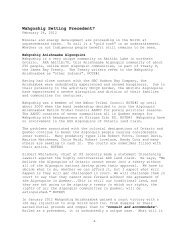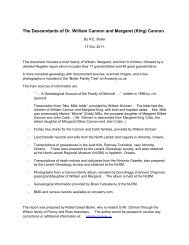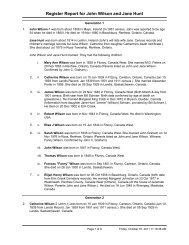A Stub Matched Lazy H for 17 M Introduction The author has ...
A Stub Matched Lazy H for 17 M Introduction The author has ...
A Stub Matched Lazy H for 17 M Introduction The author has ...
Create successful ePaper yourself
Turn your PDF publications into a flip-book with our unique Google optimized e-Paper software.
A <strong>Stub</strong> <strong>Matched</strong> <strong>Lazy</strong> H <strong>for</strong> <strong>17</strong> M<br />
<strong>Introduction</strong><br />
<strong>The</strong> <strong>author</strong> <strong>has</strong> experimented with various configurations of the classic <strong>Lazy</strong> H<br />
antenna and a version optimised <strong>for</strong> operation on the <strong>17</strong> M band is shown in Figure 1.<br />
<strong>The</strong> antenna conductors are 14 SWG seven strand copper, and all transmission lines<br />
and the stub are constructed from 450 ohm window line.<br />
29 ft.<br />
50 ft. agl<br />
450 ohm<br />
transposed<br />
20 ft. 25 ft.<br />
25 ft. agl<br />
14 ft. 2"<br />
all transmission lines<br />
450 "window"<br />
450 ohm<br />
TL to rig<br />
approx. 160 ft.<br />
3 ft. 4"<br />
s/c stub<br />
Figure 1 – <strong>Lazy</strong> H Dimensions<br />
Note that the stub method of matching described here is inherently narrowband, and<br />
prevents the antenna being used effectively on other bands, particularly 7 MHz, 14<br />
MHz and 21 MHz, where it can still produce useful radiation patterns. If this is a<br />
concern, then it is preferable to just accept the slight loss of gain and trickier tuning<br />
with the unmatched configuration. If the transmission line run is relatively short, say<br />
less than 50 ft., then this should not be a problem in practice, but with longer runs the<br />
losses can be quite significant if the SWR on the 450 ohm line is already high, and the<br />
matching can be very susceptible to water or wet snow on the line. In my installation<br />
the transmission line was required to be around <strong>17</strong>5 ft. in length so I decided to install<br />
a stub at the antenna to match the antenna impedance to the 450 ohm transmission<br />
line impedance over the <strong>17</strong> M band.<br />
Antenna Pattern and SWR Plots<br />
Figure 2 shows the elevation radiation pattern of the <strong>Lazy</strong> H over medium ground.<br />
Maximum gain is 12.3 dBi at an elevation angle of 18 degrees. At 5 degrees the gain<br />
is still a respectable 5.4 dBi. <strong>The</strong> patterns are independent of the stub match since the<br />
model assumes zero transmission line and mismatch loss.
Figure 2 – Elevation Radiation Pattern<br />
<strong>The</strong> corresponding azimuth pattern at 18 degrees take off angle is shown in Figure 3.<br />
Figure 3 – Azimuth Radiation Pattern<br />
<strong>The</strong> azimuth pattern maxima are at right angles to the plane of the antenna, or NE /<br />
SW as installed at the <strong>author</strong>’s QTH in eastern Ontario.<br />
Figure 4 shows the antenna SWR into 450 ohms, without stub matching and plotted<br />
from 15 to 20 MHz.
Figure 4 – Unmatched 15 to 20 MHz VSWR<br />
At 18.14 MHz the SWR is 6.4:1, with Z 0 = 277 + j734. Variation over the band is<br />
insignificant. <strong>The</strong> antenna there<strong>for</strong>e presents a fairly high inductive reactance<br />
loading, but with a reasonably well-matched resistive component.<br />
Line Losses and SWR<br />
<strong>The</strong> SWR measured by a 450 ohm balanced bridge at the transmitter end of the line,<br />
be<strong>for</strong>e matching and in dry weather, was 6.5:1 at 18.14 MHz, or close to the model<br />
value. A repeat check made when the feeder was wet due to moderate rain gave a<br />
measured SWR of around 4. <strong>The</strong> rain also required retuning of the Z match tuner<br />
usually used to match the antenna feed line to the 50 ohm unbalanced transceiver RF<br />
port.<br />
<strong>The</strong> loss due to <strong>17</strong>5 ft. of 450 ohm transmission line between the tuner and the centre<br />
of the lower element of the antenna was estimated at 0.12 dB / 100 ft. from the chart<br />
(Fig. 19.4) in the ARRL Handbook (1999). Applying the <strong>for</strong>mulae shown below<br />
gives the actual loss (around 0.5 dB) <strong>for</strong> <strong>17</strong>5 ft. of line operating at 6.5:1 SWR.<br />
This may not appear to be a particularly significant loss; however the calculation<br />
assumes dry transmission line under ideal conditions. In wet weather the line losses<br />
almost certainly increase, and there is the additional inconvenience of having to reset<br />
the antenna tuner.
<strong>Matched</strong> line loss:<br />
SWR at load:<br />
ML := .12<br />
ML<br />
10<br />
a := 10<br />
SWR := 6.5<br />
dB per 100 ft. from ARRL HB pp.19.5<br />
ρ :=<br />
SWR − 1<br />
SWR + 2<br />
Mismatched line loss:<br />
Measured line length:<br />
MML := 10⋅log<br />
MML = 0.285<br />
L := <strong>17</strong>5<br />
MML = 0.499<br />
<br />
<br />
<br />
<br />
<br />
<br />
a 2 − ρ 2<br />
a⋅<br />
1 − ρ<br />
ft.<br />
dB<br />
<br />
( ) 2 <br />
<br />
MML :=<br />
L⋅<br />
MML<br />
100<br />
dB per 100ft.<br />
Matching <strong>Stub</strong> Calculations<br />
<strong>The</strong> first step is to calculate the position of the first current maximum on the<br />
transmission line, working from the antenna. In the absence of a suitable current<br />
probe, the best method is to work in from the outer end of the antenna elements to<br />
find the position of the first current maximum on the transmission line. At this point<br />
the impedance on the line consists of a real resistive component equal to the<br />
characteristic impedance of the line in parallel with a reactive component.<br />
In this case the length of one of the lower elements (29 ft.) is 0.53 λ, where λ = 54.22<br />
ft.. Since the element length is of the order of ½ λ, the next accessible current<br />
maximum occurs at ¾ λ from the outer end of the element, or at L = 0.25 – 0.03 =<br />
0.22 λ along the transmission line from its junction with that element. Taking the<br />
velocity factor of the line into account, L is given by: L = 54.22 x 0.22 x 0.95 = 11.33<br />
ft. In the case of the upper set of elements, also 0.53λ in length, there is an additional<br />
20 ft. of p<strong>has</strong>ing line to take into account. Ideally the length of this line should be<br />
0.5λ or 25.75 ft, accounting <strong>for</strong> the 0.95 velocity factor, in which case the current<br />
maximum due to the upper elements would coincide with the position of the<br />
maximum due to the lower elements. However a shorter p<strong>has</strong>ing line length of 20 ft.<br />
is used in the antenna described here because it allows tension to be maintained in the<br />
p<strong>has</strong>ing line and, according to the model, the shorter p<strong>has</strong>ing line actually improves<br />
the gain by a few 10ths of a dB (attempts to use the ideal 25.75 ft. length with 25 ft.<br />
vertical support halyard spacing resulted in excessive thrashing under high wind<br />
conditions and broken p<strong>has</strong>ing line connections). <strong>The</strong> current maximum <strong>for</strong> the upper<br />
elements thus occurs at 5.75 ft. closer to the transmitter than that <strong>for</strong> the lower<br />
elements. A compromise stub position of 11.33 + 5.75/2 = 14.2 ft. (14 ft. 2”) is<br />
there<strong>for</strong>e indicated.<br />
<strong>The</strong> next step is to find the required length of a short circuit stub to connect at the<br />
current maximum to in order to compensate <strong>for</strong> the antenna’s reactive impedance.<br />
<strong>The</strong> procedure is to draw a circle on the Smith chart as shown in Figure 5,<br />
corresponding to the measured 6.5:1 SWR and centred on R/Z 0 = 1. This circle<br />
crosses the unit resistance circle at a point corresponding to an inductive reactance of<br />
j2.3. Follow the j2.3 curve to the edge of the chart and note the reading on the
wavelength scale. <strong>The</strong>n calculate the total length in wavelengths from this point to<br />
the infinite susceptance (short circuit) point on the right of the horizontal axis. In this<br />
example the j2.3 curve intersects the 0.185λ point on the outer scale, and the<br />
difference between this value and 0.25λ, corresponding to infinite susceptance, is<br />
0.065λ, or 54.22 x 0.95 = 3.34 ft (3 ft. 4”).<br />
Figure 5 – Smith Chart<br />
A short circuit stub was made from 450 ohm line to the above length and attached in<br />
parallel with the transmission line at the previously calculated position of the current<br />
maximum (14 ft. 2”). <strong>The</strong> measured SWR improved to 1.2:1 at the center of the 18<br />
MHz band, with negligible variation over the band. If necessary the SWR can be<br />
optimized by adjusting the stub dimensions after observing the frequency at which<br />
minimum SWR is obtained. For example if this frequency is higher than the desired<br />
operating frequency by X%, then the stub spacing from the antenna feed point and<br />
stub length can be increased by 0.95X%. In practice it appears that stub position is<br />
the more critical dimension so try this first.<br />
<strong>The</strong> stub match was found to considerably reduce environmental detuning effects. An<br />
additional benefit is that the stub provides a DC short circuit across an otherwise open<br />
circuit antenna thereby reducing the chances of static build up and allowing <strong>for</strong><br />
straight<strong>for</strong>ward ohm-meter transmission line continuity checks.<br />
Nick Shepherd VE3OWV




